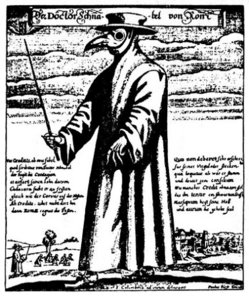Types
ICD-10 codes are provided below.
- (A20.0) Bubonic plague is an infectious disease that is believed to have caused several epidemics or pandemics throughout history. The disease is caused by the bacterium Yersinia pestis. Bubonic plague is the most common form of plague, and is characterized by swollen, tender, inflamed lymph glands (called buboes).
- (A20.7) Septicemic plague occurs when plague bacteria multiply in the blood.
- (A20.2) Pneumonic plague occurs when the lungs are infected.
Infection/transportation
Bubonic plague is primarily a disease of rodents, particularly marmots (in which the most virulent strains of plague are primarily found), but also black rats, prairie dogs, chipmunks, squirrels and other similar large rodents. Human infection most often occurs when a person is bitten by a rat flea (Xenopsylla cheopsis) that has fed on an infected rodent. The bacillus multiplies in the stomach of the flea, blocking it. When the flea next bites a mammal, blood consumed by the flea is regurgitated along with the bacillus into the bloodstream of the bitten animal. Any serious outbreak of plague is started by other disease outbreaks in the rodent population. During these outbreaks, infected fleas that have lost their normal hosts seek other sources of blood.
In 1894, bacteriologists Alexandre Yersin and Shibasaburo Kitasato independently isolated the responsible bacterium and Yersin further determined that rodents were the likely common mode of transmission. The disease is caused by the bacterium Yersinia pestis.
Symptoms and treatment
The disease becomes evident 2–7 days after infection. Initial symptoms are chills, fever, headaches, and the formation of buboes. The buboes are formed by the infection of the lymph nodes, which swell and become prominent. If unchecked, the bacteria infects the bloodstream (septicemic plague), and can progress to the lungs (pneumonic plague).
In septicemic plague there is bleeding into the skin and other organs, which creates black patches on the skin. Untreated septicemic plague is universally fatal, but early treatment with antibiotics (usually streptomycin or gentamicin) is effective, reducing the mortality rate to around 15% (USA 1980s). People who die from this form of plague often die on the same day symptoms first appear.
With pneumonic plague infecting lungs comes the possibility of person-to-person transmission through respiratory droplets. The incubation period for pneumonic plague is usually between two and four days, but can be as little as a few hours. The initial symptoms of headache, weakness, and coughing with hemoptysis are indistinguishable from other respiratory illnesses. Without diagnosis and treatment, the infection can be fatal in one to six days; mortality in untreated cases may be as high as 95%. The disease can be effectively treated with antibiotics.
Read more at Wikipedia.org


